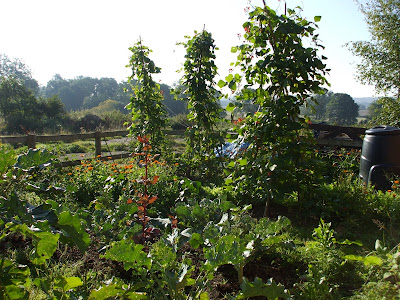I'm looking ahead to a number of years with two small children at home. This means gardening is going to need to get seriously low maintenance. I'm really going to need to get to grips with perennial vegetables! Here's my hit list of plants that I'm going to try growing to replace a lot of the annuals I usually grow.
Familar Vegetables
Shallots/potato onions (potato onions are similar to shallots but, depending on variety, can grow to up to 4 inches across in ideal conditions). They like rich, well drained and constantly moist soil. Other onion family plants worth trying include welsh onions for spring onion sized perennials - simply replant a few for a replenished harvest. And perennial sweet leeks for an oniony leaf crop.
Asparagus Likes a rich, well drained soil with pH close to 7. Likes a good water supply, even after you've finished harvesting the shoots.
Runner beans

Climbing runner beans are actually perennial plants, although we tend not to encourage them to grow like this here in the UK at least. There have been reports of them growing for up to 20 years in this country! A particularly hardy variety is the 'White Dutch' bean, available from the seed savers exchange. Grow them in a warm spot in the garden and give them a heavy mulch over winter.
Tree collards (perennial cabbage). These don't form heads, but have harvestable leaves, said to look much like savoy cabbage leaves. You harvest the ends of its shoots when the plant is 30cm tall and then after it has formed side shoots, again, harvest the ends of the shoots. After a few years, when it gets a bit leggy, cut it back to about 30cm tall. It's worth propagating more plants from cuttings as well at this time, as not all plants will survive their coppicing.
Perennial broccoli ('nine star perennial'). Grows white heads a bit like cauliflower that are edible raw or cooked. Only produces for around 3 years though.
Perennial lettuce (Lactuca perennis). Tastes better before flowering - i.e. in early spring. Can be used as a cut and come again, which will help hold off flowering. Likes a light, sandy loam.
Reichardia picroides (another type of perennial lettuce). Can have mild leaves year round. Likes a little shade in summer and full sun the rest of the year, so might be worth working out some kind of companion planting situation that would provide shade at the right time. Use as a cut and come again, cutting all leaves off at once. Apparently this plant is slug repellant.
Less Familiar Vegetables
Lovage Basically, this is a large, perennial celery plant. Eat young spring stems and leaves, which have a milder flavour than those later in the year. Or blanch stems in spring to make them taste milder. Can also eat roots and use seeds as flavouring. Grows in full sun or part shade, in normal garden soil.
Sorrel

Edible leaves nearly all year round. A good variety to go for is 'profusion' as this doesn't flower, so you get good leaves for a longer season than most and so it doesn't become weed-like and spread all over the garden. They make good companion plants as they have deep roots that bring nutrients up from deep in the soil.
Burnet This is a hardy native plant in the UK that used to be cultivated as a salad crop back in Victorian times. Its tender young leaves are said to taste like cucumber. It will grow in any soil type. Propagation is by seed or by division in february.
Sea kale Blanch spring shoots for an asparagus-like crop. The flower buds are also edible, used much like broccoli. Then the leaves of more mature plants can be eaten after the flowers have finished in late autumn. The roots are also edible. Plants grow to about 3 feet (90cm) high and wide. It prefers full sun for shoot production. It likes a rich, fertile soil. It can be propagated by division or with root cuttings. Don't harvest until the 3rd year.
Yams Suggested species for temperate climates include chinese yam and jinenjo. You eat the root, which comes either as a clump of roots - replant one for next year, or it comes as a large single root, in which case you cut the top third off and replant it.
Daylilies Edible varieties have edible buds and flowers. Very productive. This sounds like a great one to try out as they thrive on neglect! It's happy with wet or dry soil and with either full sun or partial shade. It's also fine in a poor soil.

An interesting selection there, especially the perennial lettuces which I had'nt heard of. Interesting about Runner Beans being perennial.
ReplyDeleteIt would be good to know where some of the unusual ones can be obtained!
ReplyDelete